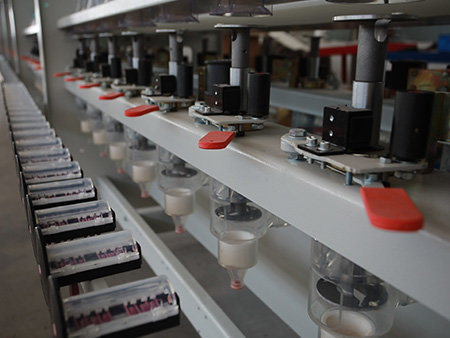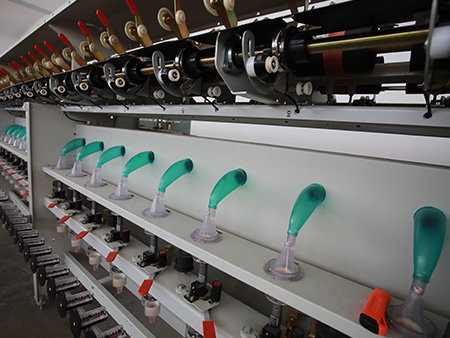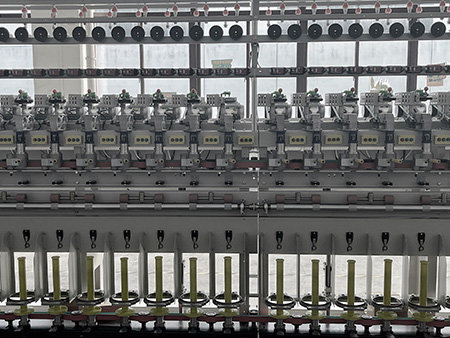
Research progress of 5 novel yarns: core-spun yarn, color-spun yarn, slub yarn, and segment-colored yarn
Release time:
2024-08-08 15:32
Zhejiang is located in the southeast coast. Although it has the advantages of abundant market information and fast product changes, it lacks natural fibers such as cotton and wool, and its processing costs are one of the highest in the country. This situation determines that Zhejiang spinning enterprises cannot take the conventional production path, but must take the differentiated, characteristic, and multi-variety production method. Therefore, Zhejiang spinning enterprises started early and developed rapidly in the research and development and production of novel yarns such as fancy yarns and fancy yarns.
1 R&D and production of core-spun yarn
Core-spun yarn is a composite fancy yarn, which is composed of two raw materials: core yarn and outer fiber. In the early 1990s, DuPont (DuPont) of the United States launched "Lycra® elastic fiber" (spandex). Because of its excellent elasticity and recovery, core-spun yarn began to gradually become popular. Lycra® elastic yarn is used as the core yarn and cotton fiber is wrapped to spin various specifications of core-spun yarn to replace the warp and weft yarn of woven fabrics and the yarn for knitting. Since spandex core-spun yarn has excellent elasticity and recovery, it can make up for the shortcomings of poor elasticity and easy wrinkling and deformation of pure cotton fabrics when worn on woven fabrics. It can show the beauty of human body lines when used on knitted fabrics, especially in women's swimwear and knitted clothing. Due to the expansion of market demand, more and more Zhejiang spinning companies are producing core-spun yarns, especially in Ningbo, Xiaoshan knitted fabric production areas and Jinhua cotton fabric production bases. The spinning companies have made the production of spandex core-spun yarn one of the key varieties.
Although the current production volume of core-spun yarn is less than before, the technology for producing core-spun yarn is constantly improving. Its development trend is as follows: (1) Spandex core-spun yarn is developing towards high-count yarn. In the past, spandex core-spun yarn was mainly produced in the form of medium-coarse yarn, such as 32S+40D, 21S+70D, 12S+100D, etc. Currently, 40S~60S spandex core-spun yarn is also produced, such as 40S+30D, 60S+20D, etc.; (2) Core-spun yarn is developing towards non-elasticity. For example, in recent years, under the guidance of experts and professors from Jiaxing College, Zhejiang Chunjiang Light Textile Group has successively developed new core-spun yarns such as 60S pure cotton-spun polyester low-elastic yarn and metal-spun yarn, and put them into mass production. (3) Develop double-core core-spun yarn. For example, Haining Bafang Textile Co., Ltd. is a leading enterprise in Zhejiang Province that specializes in the production of denim fabrics and clothing. In the past, when using spandex core-spun yarn to process denim clothing, the high elasticity of spandex yarn made the clothing feel restrained when worn. In response to the defects of spandex core-spun yarn denim fabrics, they developed double-core core-spun yarn, which uses short fibers as the outer material and two filaments with different characteristics as the core yarns. The yarn is twisted and spun into yarn.
Research, development and production of 2-color spinning
Colored yarn is a leading product in the field of fancy yarns. Zhejiang spinning enterprises began to develop and produce colored yarn from the late 1980s to the early 1990s. Over the past 20 years, Zhejiang's colored spinning production has gone through four stages of development. Ninghai Cotton Mill and Jinhua Cotton Mill took the lead in developing and producing pure cotton "hemp gray yarn" and polyester "hemp gray yarn" using two kinds of black and white cotton and polyester. Later, with the establishment of Ningbo Bailong and Zhejiang Huafu Group, based on the strong R&D strength of the two groups, they successively developed the production of colored yarns using cotton of various colors and mixed-color yarns produced by combining a variety of different performance raw materials. Since entering the 21st century, many colored spinning companies in Zhejiang have developed various fancy yarns based on their experience in "hemp gray yarns", multi-colored yarns, and multi-fiber blended colored yarns, relying on the company's strong technical and equipment advantages. Production technology is applied to the production of colored yarn. Integrating multiple spinning technologies into one, the color-spun yarns produced are not only diversified in raw material combinations and color combinations, but also undergo significant changes in the shape and structure of the color-spun yarns, which not only expands the possibilities of color-spun yarns varieties, and greatly improved the quality of colored yarn.
At present, enterprises producing colored spun yarn in Zhejiang have widely applied the technology of producing various fancy yarns to develop new colored spun yarns. Due to the novel style of the products, they are welcomed by subsequent processing enterprises. The novel colored spun yarns have gradually become the leading products of colored spun yarns, and have achieved good economic benefits for enterprises. For example, there is a small colored spun enterprise in Ningbo. Among the more than 30,000 ring spinning machines, more than 50% are used to produce new colored spun yarns such as colored spun segment yarns and bamboo knot yarns. The company's long-term orders are full, the supply is in short supply, and outsourcing is issued, which has created considerable economic benefits for the company. Colored spun yarn has become a competitive product of Zhejiang's spinning industry, and it occupies an important position in both the international and domestic markets.
3 R&D and production of slub yarn
Slub yarn is a fancy yarn developed earlier on ring spinning frames. Slub yarn is used on knitted cotton fabrics to give the fabric surface an irregular slub style. Pinghu Cotton Textile Factory is the first enterprise in Zhejiang Province to develop slub yarn, and has successfully applied it to pure cotton knitted fabrics.
Since the beginning of the 21st century, due to the popularity of slubby style in denim clothing, the demand for slubby yarn has increased greatly, but most denim originally used rotor spinning as warp and weft yarn. Due to the high technical difficulty and high cost of transformation of rotor spinning machines to develop slubby yarn, the warp yarn for denim has gradually changed from rotor spinning to ring spinning slubby yarn. Ring spinning produces slubby yarn by relying on the asynchronous rotation speed of the front, middle and rear rollers of the spinning machine, which causes slubby yarn to form on the yarn. Its transformation is much easier than rotor spinning. Due to the increasing demand for slubby yarn for denim, the number of companies producing slubby yarn has gradually increased. Most of them use servo motors to control slubby yarn devices produced by domestic Hengjiu Electric Technology Co., Ltd., etc. The thickness and pitch of the slubby can be adjusted arbitrarily, so that the production of slubby yarn has developed from the original mechanical control method to intelligent control. This is a major progress and has effectively promoted the development of slubby yarn.
Research, development and production of 4-section colored yarn
Segmented colored yarn is a novel fancy yarn first developed by Hangzhou No.2 Cotton Mill in Zhejiang Province. It was called "Mengli Yarn" and applied for an invention patent. The apparent form of "Mengli Yarn" is a composite yarn, which is very different from bamboo yarn. It is a segmented colored yarn that is produced by feeding two rovings from the drafting area of the back roller and the middle roller respectively, and using a servo motor to control the continuous feeding of one roving and the intermittent feeding of the other roving. After many domestic spinning companies adopted this technology, they changed from "Mengli Yarn" to "Segmented Colored Yarn". Since segmented colored yarn is a composite spinning, the two rovings are divided into base yarn and decorative yarn, and a roving fed intermittently is covered on a base yarn, so it is called segmented colored yarn. Segmented colored yarn has a unique multi-color irregular combination fancy style. Not only can the yarn have the same thickness change as bamboo yarn in the axial direction, but also the same cross-section of the yarn is composed of a variety of colored fibers, showing an irregular and intermittent distribution state. The color change is more layered and three-dimensional, which is more in line with the fashion trend of clothing.
Fabrics made of segment-colored yarn have soft and full colors and a strong sense of layering, so they have a broad market space. The number of enterprises producing segment-colored yarn in Zhejiang Province is constantly expanding. Segment-colored yarn was first used in the production of colored yarn. Bailong Dongfang and Zhejiang Huafu, two colored yarn spinning groups, are the units that apply segment-colored yarn technology the most in colored yarn spinning. At present, it has been expanded to key colored yarn spinning enterprises in Zhejiang Province. At the same time, segment-colored yarn technology has also been expanded to the production of natural yarn production enterprises and semi-worsted and wool spinning enterprises. Grey yarn enterprises can use the differences in dyeing properties of various fiber raw materials to produce segment-colored yarn, and present the style of segment-colored yarn in the subsequent processing. Semi-worsted and wool spinning enterprises use a variety of colors of raw materials to match each other when producing segment-colored yarn. High-end sweaters woven with segment-colored yarn are well received by domestic and foreign customers.
5. Research and development of fancy yarn
At the end of the 1970s, Zhejiang textile enterprises began to pay attention to the research and development and production of fancy yarns. The first experimental workshop in the province specializing in the research and development of fancy yarns was established in Hangzhou No. 1 Cotton Textile Factory. Advanced processing equipment such as Treff spinning machines and fancy twisting machines were introduced from abroad, and equipment for producing chenille yarns was purchased from China. A group of professional and technical personnel were equipped to engage in the research and development of various fancy yarns. Coarse-count fancy yarns made of low-grade cotton and recycled cotton using Treff spinning equipment (also known as friction spinning machines) were developed and produced, and applied to decorative fabrics. Gold and silver fancy yarns, colorful fancy yarns, and various overfeed-type fancy yarns such as circle yarns, wave-shaped yarns, knotted yarns, braided yarns, etc. were developed on fancy twisting machines, and chenille yarns of various colors were developed on domestic chenille yarn machines. Various types of fancy yarns were successfully developed in the Hangzhou No. 1 Cotton Yarn Experimental Workshop, which gradually developed the production of fancy yarns in Zhejiang. At present, factories specializing in the production of fancy yarns have been built in Yuhang District, Xiaoshan District, Deqing, Haiyan, Ningbo, Xiangshan, Changshan and other places in Hangzhou.
Previous Page
Previous Page
Dye prices have skyrocketed to an unprecedented level
2022-12-07
2022-12-07
2022-12-07




